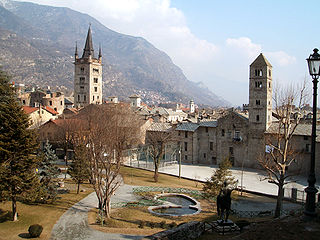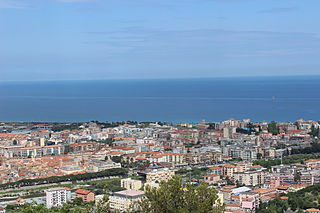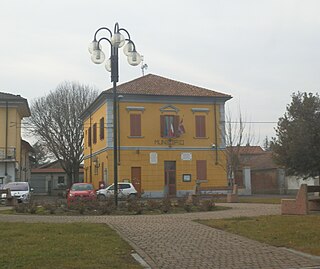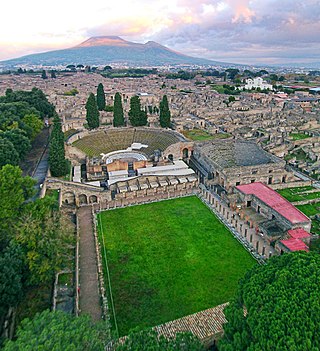
Piedmont is a region of Northwest Italy, one of the 20 regions of Italy. It borders the Liguria region to the south, the Lombardy and Emilia-Romagna regions to the east, and the Aosta Valley region to the northwest; it also borders Switzerland to the north and France to the west. It has an area of 25,402 km2 (9,808 sq mi) making it the second largest region of Italy after Sicily; as of 31 January 2021, the population was 4,269,714. The capital of Piedmont is Turin, which was also the capital of the Kingdom of Italy from 1861 to 1865.

Asti is a comune (municipality) of 74,348 inhabitants (1–1–2021) located in the Italian region of Piedmont, about 55 kilometres east of Turin, in the plain of the Tanaro River. It is the capital of the province of Asti and it is deemed to be the modern capital of Montferrat.

Tourism in Italy is one of the economic sectors of the country. With 65 million tourists per year (2019) according to ISTAT, Italy is the fifth most visited country in international tourism arrivals. According to 2018 estimates by the Bank of Italy, the tourism sector directly generates more than five per cent of the national GDP and represents over six per cent of the employed.

Susa is a town and comune in the Metropolitan City of Turin, Piedmont, Italy. In the middle of Susa Valley, it is situated on at the confluence of the Cenischia with the Dora Riparia, a tributary of the Po River, at the foot of the Cottian Alps, 51 km (32 mi) west of Turin.

Tortona is a comune of Piemonte, in the Province of Alessandria, Italy. Tortona is sited on the right bank of the Scrivia between the plain of Marengo and the foothills of the Ligurian Apennines. Its frazione of Vho is a member of the I Borghi più belli d'Italia association.

Albenga is a city and comune situated on the Gulf of Genoa on the Italian Riviera in the Province of Savona in Liguria, northern Italy. Albenga has the nickname of city of a hundred spires. The economy is mostly based on tourism, local commerce and agriculture. Albenga has six hamlets: Lusignano, San Fedele, Campochiesa, Leca, Bastia, Salea.

Pragelato is a comune (municipality) in the Metropolitan City of Turin in the Italian region Piedmont, located about 60 kilometres (37 mi) west of Turin, in the upper Val Chisone. The name Pragelato, meaning "icy meadow", has been derived from the harsh climate and the fact that the ground is covered with ice for long periods. On both sides of the Chisone, extensive forests of pine and larch provide protection from the avalanches which are a common occurrence in the winter season: for this reason in the nineteenth century the people of Pragelato were only permitted to fell trees close to the mountain summits, and even then only with the permission of the communal administration.

Serravalle Sesia is a comune (municipality) in the Province of Vercelli in the Italian region Piedmont, located about 80 kilometres (50 mi) northeast of Turin and about 40 kilometres (25 mi) north of Vercelli.

Alzano Scrivia is a comune (municipality) in the Province of Alessandria in the Italian region Piedmont, located about 90 kilometres (56 mi) east of Turin and about 25 kilometres (16 mi) northeast of Alessandria. As of 31 December 2004, it had a population of 409 and an area of 2.1 square kilometres (0.81 sq mi).

Arquata Scrivia is a comune (municipality) in the Province of Alessandria in the Italian region Piedmont, located about 100 kilometres (62 mi) southeast of Turin and about 35 kilometres (22 mi) southeast of Alessandria.

Cabella Ligure is a comune (municipality) in the Province of Alessandria in the Italian region Piedmont, located about 120 kilometres (75 mi) southeast of Turin and about 45 kilometres (28 mi) southeast of Alessandria.
Castelnuovo Scrivia is a comune (municipality) in the Province of Alessandria in the Italian region Piedmont, located about 90 kilometres (56 mi) east of Turin and about 20 kilometres (12 mi) northeast of Alessandria.

Gavi is a comune (municipality) in the Province of Alessandria in the Italian region Piedmont, located about 100 kilometres (62 mi) southeast of Turin and about 30 kilometres (19 mi) southeast of Alessandria.

Isola Sant'Antonio is a comune (municipality) in the Province of Alessandria in the Italian region Piedmont, located about 90 kilometres (56 mi) east of Turin and about 20 kilometres (12 mi) northeast of Alessandria.

Pontecurone is a comune (municipality) in the Province of Alessandria in the Italian region Piedmont, located on the left bank of the Curone, about 100 kilometres (62 mi) east of Turin and about 25 kilometres (16 mi) east of Alessandria.

Serravalle Scrivia is a comune (municipality) in the Province of Alessandria in the Italian region of Piedmont, located about 100 kilometres (62 mi) southeast of Turin and about 25 kilometres (16 mi) southeast of Alessandria.
Stazzano is a comune (municipality) in the Province of Alessandria in the Italian region Piedmont, located about 100 kilometres (62 mi) southeast of Turin and about 30 kilometres (19 mi) southeast of Alessandria. As of 31 December 2004, it had a population of 2,168 and an area of 17.8 square kilometres (6.9 sq mi).

Vignole Borbera is a comune (municipality) in the Province of Alessandria in the Italian region of Piedmont, located about 100 kilometres (62 mi) southeast of Turin and about 30 kilometres (19 mi) southeast of Alessandria. As of 31 December 2004, it had a population of 2,154 and an area of 8.5 square kilometres (3.3 sq mi).

Pompeii was an ancient city located in what is now the comune of Pompei near Naples in the Campania region of Italy. Pompeii, along with Herculaneum and many villas in the surrounding area, was buried under 4 to 6 m of volcanic ash and pumice in the Eruption of Mount Vesuvius in 79 AD.

The Amphitheatre of Libarna is found in the ancient Roman city of Libarna, near the modern town of Serravalle Scrivia, in Piedmont. It was discovered in excavations throughout the 20th century alongside remains of bath buildings.



















